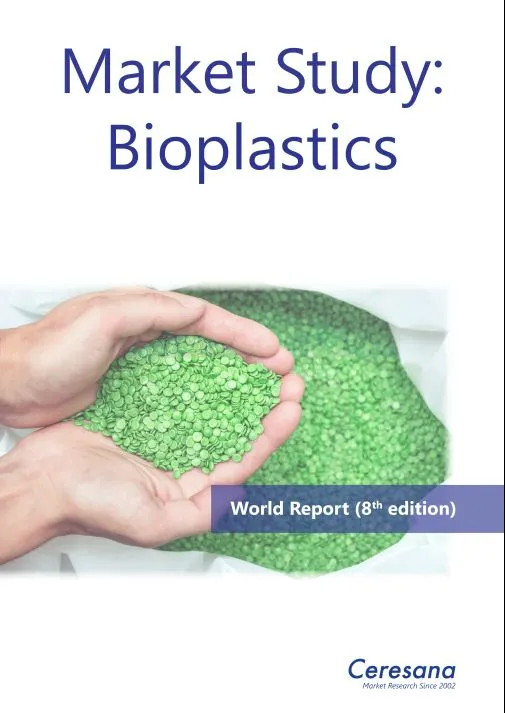
How much biobased content do bioplastics really contain? More and more, this is becoming a mathematical question: Biomass-based polymers are increasingly being added to conventional petroleum or natural gas plastics. Legislators and certification bodies decide at which organic content and with which properties these “bioattributed” or “mass-balanced” materials may be sold as bioplastics. In any case, demand for alternative plastics is high, and “bio” versions are now available for virtually all grades and applications. This is the eighth time that Ceresana has investigated the dynamically growing global market for “green” polymers: Analysts expect revenues generated with bioplastics to increase to around USD 11.4 billion by 2032.
Compostable Plastics for the Circular Economy
So far, there is no generally accepted definition and no uniform labeling for bioplastics. The European Union Commission published conditions for bioplastics in November 2022. They should have “a positive impact on the environment, rather than exacerbating plastic pollution, climate change and biodiversity loss”. According to this, the biomass for bioplastics should “come from sustainable sources,” preferably organic waste and by-products. Products that “could be carelessly discarded” should not be allowed to be labeled as “biodegradable”. Petrochemical oxo-degradable plastics, which break down into small pieces when exposed to air and light, have already been banned in Europe since 2021.
Ceresana’s current bioplastics market study primarily examines thermoplastics made from renewable raw materials that are biodegradable, i.e. can be decomposed by microorganisms in nature or at least composted in industrial plants. PHA from sugar and TPS from starch, for example, are biobased and biodegradable. However, there are also plastics made from biogenic raw materials that are not compostable, for example PEF made from fructose or bio-polyethylene based on sugar cane. The market study also covers petrochemical biodegradable plastics – such as PCL, PBAT or PBS. Notincluded here, however, are biobased elastomers, thermosets, natural fiber-reinforced plastics (NFRP), and composites such as wood-plastic composites (WPC).
Sustainable Packaging Made from Polylactic Acid and Starch
According to the EU Commission, bioplastics should preferably be used in durable products. However, today they are commercially successful mainly in applications where compostability is important: The most important sales market for biopolymers is the packaging industry, which currently processes almost 60% of all bioplastics. Ceresana expects the highest growth over the next few years in the bags, sacks and pouches division. Biodegradable plastics, particularly polylactic acids (PLA) and starch polymers, currently account for 68% of the total bioplastics market. For this product group, Ceresana’s current market study forecasts further growth of 11.7% per year up until 2032. Biobased but non-biodegradable plastics, such as bio-polyethylene, PET or PA, are expected to increase at lower rates of 7.8% per year.

The Study in Short:
Chapter 1 of the study provides a comprehensive presentation and analysis of the global market for bioplastics – including forecasts up to 2032: For each region, the development of demand (tonnes), revenues (USD and EUR) and production (tonnes) is indicated.
In addition, the application areas of bioplastics are examined individually:
- Rigid packaging
- Flexible packaging (bags, sacks and pouches)
- Other flexible packaging
- Consumer goods
- Automotive and electronics
- Other applications
For the regions Europe, North America, Asia-Pacific and “Rest of the World”, the production of bioplastics is divided into product groups:
- Polylactic acid (PLA)
- Starch
- Other biodegradable plastics
- Non-biodegradable plastics.
The demand for bioplastics per region is broken down into different types of plastics:
- Polylactic acid (PLA)
- Starch
- Polyhydroxyalkanoates (PHA)
- Polybutylene adipate terephthalate (PBAT)
- Other non-biodegradable plastics
Chapter 2 examines the 11 most important sales countries individually: Germany, France, the United Kingdom, Italy, the Netherlands, Spain, USA, China, Japan, South Korea and Taiwan. In each case, the following are presented: demand and revenues, demand split by application area and type of product (PLA, starch-based, other biodegradable plastics, non-biodegradable biobased plastics).
Chapter 3 provides useful company profiles of the most important bioplastics manufacturers, clearly categorized by contact details, revenue, profit, product range, production sites and brief profile. Detailed profiles are provided by 120 manufacturers, e.g. BASF SE, Braskem S.A., Far Eastern New Century Corporation (FENC), NatureWorks LLC, Novamont S.p.A., Rodenburg Biopolymers B.V., Teijin Limited, Total Corbion PLA BV, and Vegeplast S.A.S.
Scope of the Report:
| Attributes | Details |
| Base Year | 2022 |
| Trend Period | 2020 – 2032 |
| Forecast Period | 2023 – 2032 |
| Pages | 350 |
| Application Areas | Rigid packaging, Flexible Packaging (Bags, Sacks, Pouches), Other flexible packaging, Consumer Goods, Automotive and Electronics, and Other Applications |
| Product Groups | Polylactic acid (PLA), Starch, Other Biodegradable Plastics, and Other Non-Biodegradable Plastics |
| Company Profiles | BASF, Braskem, FENC, NatureWorks, Novamont, Rodenburg, Teijin, Total Corbion, and Vegeplast (Selection) |
| Edition | 8th edition |
| Publication | May 2023 |
FAQs
How will bioplastics sales develop by 2032?
Analysts expect revenues generated with bioplastics to rise to approx. USD 11.4 billion by 2031.
What application area is expected to experience the highest growth?
The highest growth rates over the next few years are expected in the bags, sacks and pouches segment.
Which plastic types are not considered in this market study?
Biobased elastomers, thermosets, natural fiber-reinforced plastics (NFRP), and composites such as wood-plastic composites (WPC) are not considered in this market study.
Source
Ceresana Market Report Bioplastics, press release, 2023-05-09.
Supplier
BASF SE
Braskem
Ceresana Research
European Commission
Far Eastern New Century Corporation (FENC)
NatureWorks LLC
Novamont S.p.A.
Rodenburg Biopolymers B.V.
Teijin Ltd.
Total Corbion PLA
Vegeplast S.A.S.
Share
Renewable Carbon News – Daily Newsletter
Subscribe to our daily email newsletter – the world's leading newsletter on renewable materials and chemicals










